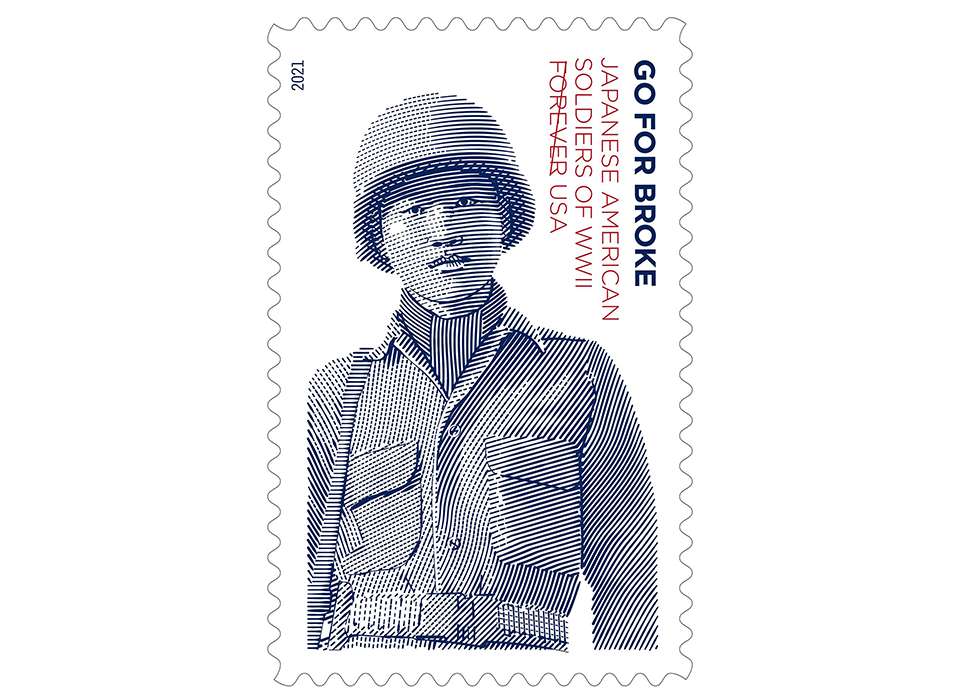Top Image: The US Postal Service’s “Go for Broke” commemorative stamp. A 1944 photo of Army Pfc. Shiroku “Whitey” Yamamoto, a Hawaiian member of the 442nd Regimental Combat Team, was the inspiration for the stamp. Photo courtesy of Stamp Our Story Coalition.
The United States Postal Service commemorated the Nisei (or second-generation Japanese Americans) who served with valor during World War II by issuing the “Go for Broke: Japanese American Soldiers of WWII” stamp in June of 2021. “Go for Broke” was the motto of the all-Nisei 442nd Regimental Combat Team, but the stamp also recognizes more than 30,000 Japanese American members of the US Army during the war. The storied 100th Infantry Battalion and 442nd (the most decorated unit of its size) saw fierce battle in the European theater; members of the 522nd Field Artillery Battalion (a detachment of the 442nd) also liberated the sub camps of the Dachau concentration camp system in April of 1945. But one of the least known groups of Japanese American soldiers deserves recognition: Company B of the 1800th Engineering Battalion.
The creation of the 1800th Company B begins with the controversial loyalty questionnaire issued to Japanese Americans in 1943 by the War Relocation Authority (the agency that oversaw the incarceration of 120,000 Japanese Americans) and the War Department. Earlier that year, the War Department searched for a way to determine the loyalty of Nisei men who would be eligible to serve in the military and created a loyalty form, also known as Selective Service Form 304A, to be distributed to all Nisei men in the camps as well as those who had been inducted into the military by 1943. Nisei men responded to a series of general questions on their background and past activities that could be interpreted as pro-Japanese (such as taking martial arts classes), but questions 27 and 28 were not as easy to answer.
Question 27 asked Nisei men if they were “willing to serve in the armed forces of the United States on combat duty, wherever ordered,” which angered those who were being asked to put their lives on the line for a nation that had imprisoned them and their loved ones. The fact that they would also be relegated to segregated units did not sit well with them. Question 28 asked if responders would agree to “swear unqualified allegiance to the United States of America and faithfully defend the United States from any or all attack by foreign and domestic forces, and forswear any form of allegiance or obedience to the Japanese emperor, or any other foreign government, power, or organization.” Nisei were especially insulted by this inquiry: How could an American citizen have any allegiance to the emperor to renounce?
The War Relocation Authority (WRA) received far fewer than the 2,000 hoped-for volunteers for the Nisei units and were also challenged by Nisei who used the questionnaire to protest incarceration. Approximately 20 percent of all Nisei eligible for service answered “no” to both questions 27 and 28, which the War Department later classified as resisting the draft. This created division in the Japanese American community between the “loyal” Nisei who volunteered for service like the 442nd and answered “yes” to questions 27 and 28 and the “disloyal” who either answered “no” to questions 27 and 28 (the No-No Boys) or refused to respond to the questionnaire at all and were placed in high-security camps or detention centers.
There was, however, a lesser-known category of Nisei men: the No-Yes boys who denounced loyalty to Japan, but protested incarceration by refusing unquestioned military service. Nisei already inducted into, or serving in, the military who answered in the affirmative to question 28, but refused to be stationed wherever needed, violated orders and were assigned to a labor unit, the 525th Quartermaster Service Company, stationed at Fort Leonard Wood, Missouri. Nisei men of the 525th were demoted to private for their disloyal responses, and the 525th became one of the mostly-Nisei units of World War II.
The Army disbanded the 525th on March 1, 1944, and transferred the Nisei soldiers to Company B of the 1800th, a diverse group in its own right. The 1800th was responsible for damage repairs to bridges and roads, and was composed of “enemy aliens” whom the military suspected of disloyalty. Company A and Company C were made up of German Americans and Italian Americans (respectively). The military classified all Japanese Americans (or “Americans of Japanese Ancestry”) as enemy aliens, and Nisei men were placed under the accompanying 4-C military status despite their American citizenship.
Cedrick Shimo, a Nisei fluent in English and Japanese, became a member of the 1800th because of his wartime protests. Shimo volunteered for the Military Intelligence Service (MIS) in December of 1942, joining other Nisei and Kibei (American-born but educated in Japan before returning to the United States) whose language skills could be of use at training in Camp Savage, Minnesota. The Army “fast-tracked” Shimo’s training so that he could enter service as quickly as possible, and promised a furlough to visit his family before graduation. Shimo looked forward to saying goodbye in-person to his mother and father who were imprisoned in the Manzanar camp in California and was devastated when his request was denied because no exceptions could be made to the exclusion orders that prohibited Japanese Americans from returning to the West Coast.
When Shimo received the loyalty questionnaire, he was so angered by the rejection of his leave request that he answered “no-yes” to questions 27 and 28. “At the time,” he later explained, “I was mentally prepared for overseas duty but when given this choice I gave an honest reply…[I was] willing to serve in the MIS only on the home front…our fight for liberty was over here not over there.” For his recalcitrance, Shimo and 20 other No-Yes students were expelled from Savage, demoted, and reassigned to the 1800th for “attitude[s] which [are] considered undesirable in a first class soldier of the Army of the United States.”
Shimo later served as a translator for many Kibei of the 1800th who spoke better Japanese than English and were frequently singled out as suspicious and disloyal for their unique backgrounds. Some openly protested their conditions and were sentenced to 15-year prison terms at the penitentiary in Leavenworth, Kansas. Others carried the stigma of perceived disloyalty with them for the rest of their lives.
Every member of the 1800th had to appear before a special hearing board to determine their discharge status. Most Nisei, like Shimo, received honorable discharges, whereas many Kibei received blue discharges which meant that the Army denied them all benefits. During the 1980s and 1990s, a lawyer worked pro bono with Shimo to schedule a rehearing for those with blue discharges. The Army Discharge Board agreed to grant a “favorable finding of fact” and to upgrade the blue discharges to honorable discharges, but the reputations of those who served in the 1800th languished in anonymity.
Though lesser-known today than their “Go for Broke” counterparts, the men of the 1800th performed crucial labor for the home front and obeyed orders as dutiful soldiers. Shimo and others were stationed in Tennessee where they lived in tent camps and were moved around the state and into the Mississippi River Valley repairing roads and bridges. During the spring of 1945, the men of the 1800th received recognition for their life-saving work after the White River in Arkansas flooded. The War Department issued a commendation later that year, praising the 1800th for doing “everything humanly possible to avert failure of inadequate levees in a record flood” and reiterating that the fact that “these extreme flood conditions were met successfully throughout was due in considerable measure to the effective work of this battalion in all its assignments.”
Once Japan surrendered in 1945, the Army reorganized Company B into the 4000th Engineering General Service Company and sent them to Camp Shelby, Mississippi. Despite their work on the home front and dedication, most men of the 1800th remained silent on their service as it was marred by the blue discharges. But Shimo was not afraid to speak out. In an interview in 1986, he praised his fellow members. “The 442nd on the European front and the thousands in the military Intelligence in the Pacific Theater have been justly glorified for making tremendous sacrifices for which we are all grateful and proud. But should the others (the majority) hold their heads in shame?” he asked. “Those who spoke out in the camps and in the Army should stand just as tall and hold their heads just as high as our Nisei veterans.”
The men of the 1800th are just some of the unsung Japanese Americans who served during World War II. Deemed un-American and demoted for their courage to speak out against discrimination while still serving their nation, remember the 1800th and the No-Yes boys when you see the “Go for Broke” stamps this summer.
Stephanie Hinnershitz, PhD
Stephanie Hinnershitz is a historian of twentieth century US history with a focus on the Home Front and civil-military relations during World War II.
Cite this article:
MLA Citation:
APA Citation:
Chicago Style Citation:





![Max Fuchs, New York City cantor, sings as Rabbi Sydney [sic] Lefkowitz, Richmond, VA, conducts the first Jewish services from Germany.](/sites/default/files/styles/max_650x650/public/2025-10/image1.jpg)



